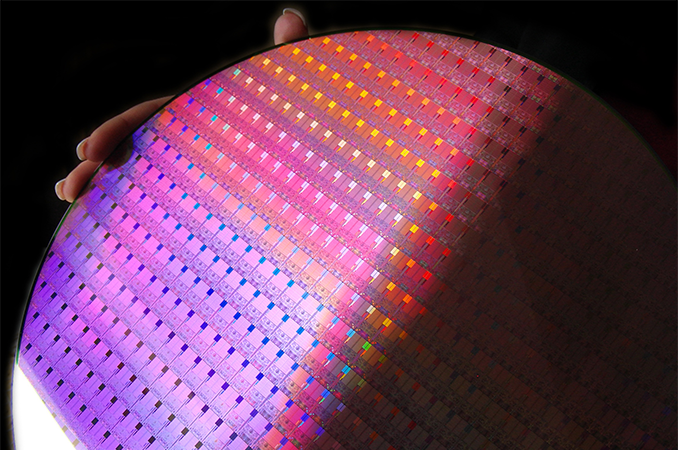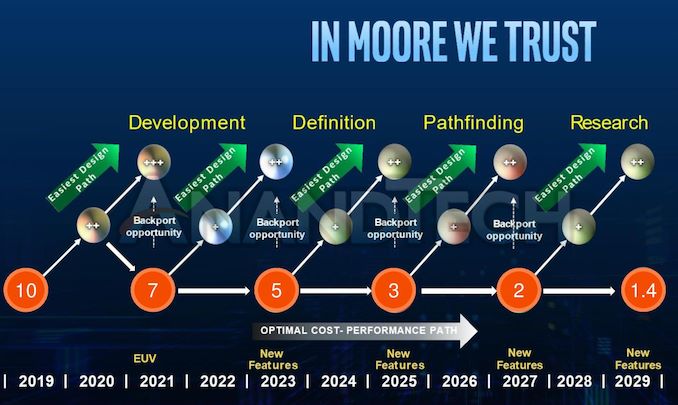Intel’s Manufacturing Roadmap from 2019 to 2029: Back Porting, 7nm, 5nm, 3nm, 2nm, and 1.4 nm
by Dr. Ian Cutress on December 11, 2019 3:00 PM EST
Update: After some emailing back and forth, we can confirm that the slide that Intel's partner ASML presented at the IEDM conference is actually an altered version of what Intel presented for the September 2019 source. ASML added animations to the slide such that the bottom row of dates correspond to specific nodes, however at the time we didn't spot these animations (neither did it seem did the rest of the press). It should be noted that the correlation that ASML made to exact node names isn't so much a stretch of the imagination to piece together, however it has been requested that we also add the original Intel slide to provide context to what Intel is saying compared to what was presented by ASML. Some of the wording in the article has changed to reflect this. Our analysis is still relevant.
One of the interesting disclosures here at the IEEE International Electron Devices Meeting (IEDM) has been around new and upcoming process node technologies. Almost every session so far this week has covered 7nm, 5nm, and 3nm processes (as the industry calls them). What we didn’t expect to see disclosed was an extended roadmap of Intel’s upcoming manufacturing processes. It should be noted that the slide presented at the conference by Intel's partner, ASML, was modified slightly from its original source.
They say a slide is worth 1000 words. Here’s 1000 words on Intel's future.

Intel's slide, as presented in September
This is Intel's original slide, not detailing which nodes in which years. However, it should be easy enough to figure out that each one of the elements in the bottom row is the next process node along, otherwise the +/++ wouldn't make sense.
ASML applied these assumptions to the slide it presented at the IEDM keynote, but the company did not disclose that they had modified the slide.

Intel's slide with ASML's animations overlayed, as shown in the slide deck distributed by ASML
So let’s go through some key areas.
1.4nm in 2029
Intel expects to be on 2 year cadence with its manufacturing process node technology, starting with 10nm in 2019 and moving to 7nm EUV in 2021, then a fundamental new node in each of 2023, 2025, 2027, 2029. This final node is what ASML has dubbed '1.4nm'. This is the first mention on 1.4nm in the context of Intel on any Intel-related slide. For context, if that 1.4nm is indicative of any actual feature, would be the equivalent of 12 silicon atoms across.
It is perhaps worth noting that some of the talks at this year’s IEDM features dimensions on the order of 0.3nm with what are called ‘2D self-assembly’ materials, so something this low isn’t unheard of, but it is unheard of in silicon. Obviously there are many issues going that small that Intel (and its partners) will have to overcome.
+, ++, and Back Porting
In between each process node, as Intel has stated before, there will be iterative + and ++ versions of each in order to extract performance from each process node. The only exception to this is 10nm, which is already on 10+, so we will see 10++ and 10+++ in 2020 and 2021 respectively. Intel believes they can do this on a yearly cadence, but also have overlapping teams to ensure that one full process node can overlap with another.
The interesting element to these slides is the mention of back porting. This is the ability for a chip to be designed with one process node in mind, but perhaps due to delays, can be remade on an older ‘++’ version of a process node in the same timeframe. Despite Intel stating that they are disaggregating chip design from process node technology, at some point there has to be a commitment to a process node in order to start the layouts in silicon. At that point the process node procedure is kind of locked, especially when it goes to mask creation.
In the slide, it shows that Intel is going to allow a workflow such that any first gen 7nm design could be back ported to 10+++, any first gen 5nm design could be back ported to 7++, and so on. One can argue that this roadmap might not be so strict with the dates – we have seen Intel’s 10nm take a long time to bake, so expecting the company to move with a yearly cadence on + updates alongside a two-year cadence with main process technology nodes would appear to be a very optimistic and aggressive cadence strategy.
Note that this isn’t the first mention of back porting hardware designs when it comes to Intel. With the current delays to Intel’s 10nm process technology, it has been widely rumoured that some of Intel’s future CPU microarchitecture designs, originally designed with 10nm (or 10+, 10++) in mind might actually find a home on a 14nm process due to the success of that process node.
Development and Research
Normally with process node developments, there will be different teams working on each process node. This slide states that Intel is currently in development of its 10+++ optimizations as well as the 7nm family. The idea is that the ‘+’ updates are capturing the low hanging fruit from a design standpoint every generation, and the number represents a full node benefit. Interestingly we see Intel’s 7nm being based on 10++, whereas in the future Intel sees 5nm come from the base 7nm design, and 3nm coming from 5nm. There is no doubt that some of the optimizations that enter each +/++ update will filter into future designs as and when they are needed.
In this slide, we have Intel’s 2023 node currently in the definition stage. At this IEDM conference there’s a lot of talk about 5nm in this timeframe, so some of those improvements (such as manufacturing, materials, consistency, etc.) will ultimately end up in Intel’s process depending on which design houses they partner with (historically Applied Materials). It is worth noting that 5nm is listed as a 2023 node, which is around the time that ASML will start selling its ‘High NA’ EUV machines to help with better path definition during the manufacturing process. I’m not sure if High NA will intercept at 5nm or 3nm, assuming this Intel roadmap has its dates correct and Intel is able to stick to it, but it is something to consider
Beyond 2023, Intel is currently in the ‘path-finding’ and 'research' mode. As always when looking this far out, Intel is considering new materials, new transistor designs, and such. At this IEDM conference we’re seeing a lot of talk of gate-all-around transistors, either as nano-sheets or nano-wires, so no doubt we’re going to see some of that as FinFET runs out of steam. TSMC is still using FinFETs for its 5nm process (Intel’s 7nm equivalent), so I wouldn’t be surprised if we see something like nano-sheets then nano-wires (or even hybrid designs) come into Intel’s manufacturing stack.
It’s worth also pointing out, based on the title of this slide, that Intel still believes in Moore’s Law. Just don’t ask how much it’ll cost.










138 Comments
View All Comments
outsideloop - Tuesday, December 10, 2019 - link
Who do you trust more in 2020 and beyond to hit node goals? TSMC or Intel?Spunjji - Wednesday, December 11, 2019 - link
Neither. TSMC dropped the ball on 32nm (cancelled the node late, leaving both GPU and mobile chip partners high and dry) and fumbled it on 20nm (power characteristics were so bad that they probably should have cancelled it; again, GPU partners notably skipped that one).Intel have historically been better, but 14nm was a mess and 10nm is an absolute travesty. I'm not sure it makes sense to assume they'll continue in the same vein, but obviously we can't just rely on their statements to the contrary after 4+ years of "10nm tomorrow".
In summary, the solid bet is that they'll both make a few questionable decisions that will hold up their process technology have wider impacts on the industry. Anything more specific than that is speculation.
CiccioB - Thursday, December 12, 2019 - link
This.People easily forget history for their convenience or due to ignorance.
We are now in a situation where Intel has failed a PP step, while TSMC was successful but did not make great things either. They just anticipated everyone that decided to use 7nm with EUV.
We will see how things will be when Samsung and Intel will come out with their EUV PPs.
That's the joint point where to do comparisons and see who will suffer.
Korguz - Thursday, December 12, 2019 - link
" People easily forget history for their convenience or due to ignorance." yes they do. like the shady dealings, theats and bribes intel made to shut amd out of the market, or the constant lies about 10nm being on track, the criticism AMD got for its power usage before Zen with their chips, but now that intel is using more power for theirs, it seems to be ok... etc etc etcsor - Tuesday, December 10, 2019 - link
This seems like a shrewd plan, they’re hedging with this parallel feature size plan. Basically they can choose to release a new CPU on either a new node or the ++ size, depending on what is developed enough to work.Everett F Sargent - Wednesday, December 11, 2019 - link
This article was published three months and 22 days too early.werpu - Wednesday, December 11, 2019 - link
Marketing papers are quickly written to keep the stock holders calm. It is either deliver or shut up...Koenig168 - Wednesday, December 11, 2019 - link
Amazing!!! Amazing that someone will actually take this 2 years cadence seriously.stephenho - Wednesday, December 11, 2019 - link
In 10 years 2029, Intel will file for chapter 11 .... they will be in 10++++ for a long long time, that is what intel does best, to fine tune a process. If AMD/TSMC is talking about anything beyond 3nm, I will sell all my AMD shares. I do not believe in anything smaller than 3nm yield will be in big big trouble.haukionkannel - Wednesday, December 11, 2019 - link
Noup... 10nm will die as soon as 7nm euv start mass production... their 10nm will newer be any good.